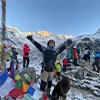Best Season for Annapurna Base Camp Trek
Choosing the right season is key to making your Annapurna Base Camp Trek a success. The best times to trek are spring (March-May) and autumn (September-November). During these months, the weather is stable, skies are clear, and the mountain views are absolutely breathtaking. Spring brings vibrant rhododendron blooms, while autumn offers crisp air and unparalleled visibility of the snow-capped peaks. Winter (December-February) is beautiful but extremely cold at higher altitudes, with temperatures dropping below freezing. Monsoon (June-August) is the least favorable due to heavy rains, muddy trails, and leeches, though the lush greenery can be appealing to some. For the best experience, plan your trek in spring or autumn to enjoy the perfect blend of weather, scenery, and trail conditions.
Accommodation & Meals During the Trek
The Annapurna Base Camp Trek is well-supported by teahouses, which are small, family-run lodges offering basic yet comfortable accommodations. Rooms are typically twin-sharing with beds, blankets, and pillows. At lower altitudes, some teahouses even provide attached bathrooms, but as you ascend, shared facilities become the norm. Meals are hearty and designed to keep you energized. You’ll find a mix of traditional Nepali dishes like dal bhat (rice with lentil soup and vegetables) and Western options such as pasta, pancakes, and pizza.
Internet, Charging & ATM Access
While trekking to Annapurna Base Camp, internet access is available at most teahouses, but it’s often unreliable, especially at higher altitudes. A Nepali SIM card with data is a more reliable and economical option for staying connected. Charging facilities are available at teahouses, but you’ll need to pay a small fee, so bringing a power bank is highly recommended. There are no ATMs along the trekking route, so make sure to withdraw enough cash in Kathmandu or Pokhara to cover your expenses, including meals, snacks, and tips.
Travel Insurance
Travel insurance is a must for the Annapurna Base Camp Trek. Ensure your policy covers emergency air evacuation and medical expenses, as the region lacks advanced healthcare facilities. In case of altitude sickness or other emergencies, you may need to be airlifted to Pokhara or Kathmandu. While the chances of needing insurance are low, it’s a critical safety net that ensures peace of mind during your adventure.
Trekking Without a Guide
The Annapurna Base Camp Trek is one of the most popular and well-marked trails in Nepal, making it possible to trek without a guide. During peak seasons, the trail is bustling with trekkers, so you’re unlikely to feel lost or alone. However, hiring a guide can greatly enhance your experience. Guides provide valuable insights into the region’s culture, history, and natural beauty, and they can help navigate tricky sections of the trail, especially during off-seasons. Whether you choose to trek independently or with a guide, the Annapurna Base Camp Trek promises an unforgettable adventure.

